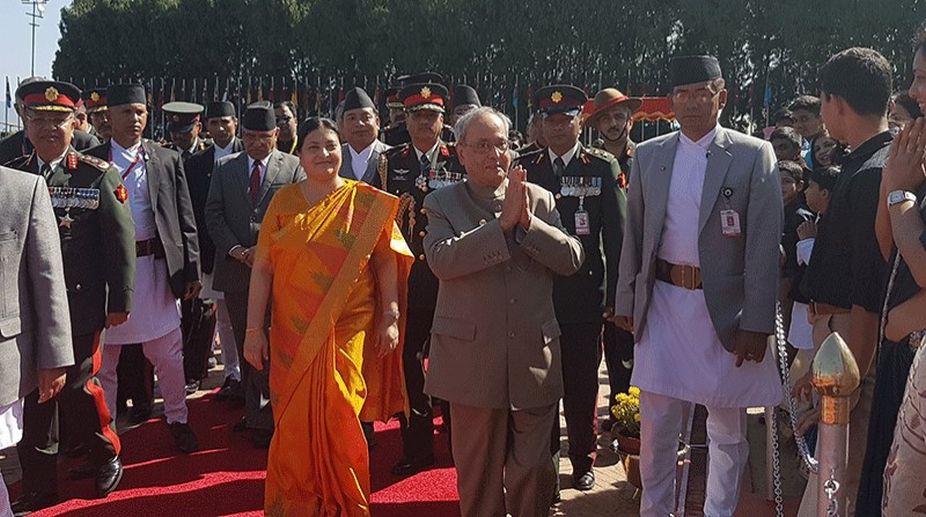Nepalese president Bidya Devi Bhandari has embarked on her maiden 5-day state visit to India. Her earlier visit was cancelled abruptly last year by the KP Sharma ‘Oli’ led government on account of alleged Indian involvement in his removal.
President Bhandari, who was one of the vice-presidents of the CPN-UML before getting elected to the highest position in 2015, was a close associate of the party chief, Oli.
Advertisement
The president is the titular head without any executive power. The impact of the visit will have to be watched to assess the extent to which it will help recoup ties after the cancellation of her last visit.
Significantly, during the last one year, there has been a change of guard in Kathmandu and PM PK Dahal ‘Prachanda’ has already visited New Delhi.
Indian president Pranub Mukherjee too made a successful visit to Nepal in early November last year. During his visit he had expressed his eagerness to receive his counterpart in Delhi as early as possible.
India believes that the first foreign visit by any Nepalese head of state and government to India is a diplomatic achievement. In reality, such visits have only cosmetic value.
Over the years, India seems to have failed in its diplomacy due to drastic change in psychological and geographic make up of Nepal, as the country no longer remains totally dependent on India for its political and economic support.
China and the international community have come up forcefully behind it. Ironically, India’s good intention to encourage democratic exercises in Nepal was taken by the monarchy and the ruling elite as interference in its internal politics since early 1950s.
The ruling elite, which took over politics by winning the Constituent Assembly elections, took exception to India’s benign suggestion to include all communities in its political fold. This was taken again as Indian interference leading to the worst period of relations and resulted in a blockade of goods at the Indian border.
Historically, Nepal-India relations acquired strategic importance after Tibet became the autonomous region of China making Nepal the buffer state between India and China. This changed the geopolitics of Nepal. It was never under British India.
But the first Btirtish resident was sent to Kathmandu in April 1802. However, formal diplomatic relations were established through the 1815- 6 treaty of Sugauli.
The Nepalese establishments had to deal with the British before 1947 in accordance with the treaties of 1792, 1801, 1815-6, 1860,and 1923. The 1815-6 treaty of Sugauli reduced the boundaries of Nepal but the treaty of 1860 extended it as a prize for helping the British army in capturing Lucknow, the capital of Avadh.
After independence, India signed the Treaty of Peace and Friendship in September 1950. More importantly, Nepal-India relations, which were decided millions of years ago by Nature, by the lofty Himalayas and the perennial rivers, were also established between two peoples settled over the adjoining border areas from times immemorial but were guided by various treaties signed from time to time during the last 250 years when Nepal acquired its present geographic boundaries.
To some, the 1950 treaty had opened up the vistas of cooperation and opportunities for development as barrages on Kosi and Gandak provided irrigation facilities not in Nepal alone but also in India and relieved millions of people of their suffering from floods in Bihar.
However, in reality, most of the provisions of the treaty have been rendered ineffective in the course of time, except the provision of free movement of citizens of each country to the other (Art.7).
It thus necessitates a timely revision. There are unseen forces in Kathmandu which ignore the security concerns of India and pressurise India indirectly to get the border regulated by itself, if not sealed. They believe the open border situation minimises the independence of the country.
Strikingly, this is against the age-old dispensation which has enabled people to go on pilgrimage in either country, allowed Nepalese to earn bread and butter in India, especially the unemployed youth from the western hills of Nepal, and encouraged the Madhesis to continue to have marital relations in Bihar and UP.
Over and above, it will curtail the easy accessibility of common people to procure materials of daily need at cheaper rates at local bazaars. Interestingly, the formation of the India-Nepal Eminent Persons' Group, whose third two-day joint meeting ended in Kathmandu on 6 April poses many questions.
Will it be possible to review the special relations by eight persons, four from each side, in a limited time frame? It is intriguing as to why the group was not made inclusive enough and left out deliberately some major communities.
The unrealistic recommendations by the Group will be difficult to implement on the one hand and these may land Nepal in yet another conflict, on the other. Some sceptics hold that the vastness of the terms of reference of the group could render the exercise futile in the 21st century, when borders are being made irrelevant throughout the world and natural resources are being harnessed for serving the humanity.
In the present context, there will hardy be any problem–centric consultations during the Presidential visit, except an overview of relations. Even current issues like reviewing vital relations as defined by the Treaty of Peace and Friendship, 1950 cannot be taken up, as the Eminent Persons Group formed by both sides is discussing it.
Of course, it cannot be ruled out that the forthcoming local level elections and the Madhesi outfits’ participation in the election do not figure in the discussions.
The writer, a former Election Commissioner of Nepal, is associated with the Nepal Transition to Peace Institute.











